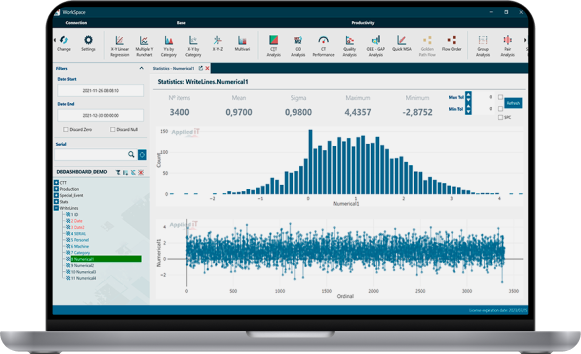In the fast-paced and competitive world of manufacturing, optimizing efficiency is crucial for staying ahead of the competition and maximizing profitability. But how exactly can you measure efficiency? One effective way to achieve this is by tracking and analyzing key metrics that provide insights into various aspects of operations. By monitoring these metrics, manufacturing businesses can identify areas of improvement, implement targeted strategies, and drive continuous improvement efforts. In the following sections, we will delve into each of these seven essential metrics, exploring their definitions, significance, and how they can be utilized to drive operational excellence.

Why Tracking Metrics is Important for Manufacturing Businesses
Before we dive into the specific metrics you should be tracking, let’s talk about why metrics tracking is so important for manufacturing businesses. First and foremost, tracking metrics is important is the ability to gain visibility into the performance of different operational areas. By measuring and analyzing metrics related to production, quality control, inventory management, and resource utilization, businesses can identify strengths, weaknesses, and areas of improvement. This data-driven approach allows them to make targeted adjustments and optimize their processes to drive operational excellence.
Furthermore, metrics facilitate data-driven decision-making. Instead of relying on intuition or guesswork, tracking metrics provides manufacturers with concrete data to guide their decision-making processes. Whether it’s optimizing production schedules, adjusting inventory levels, or evaluating supplier performance, metrics offer quantitative insights that support strategic decision-making and minimize risks.
Finally, tracking metrics is vital for manufacturing businesses to thrive in a highly competitive industry. By monitoring and analyzing key performance indicators, manufacturers can gain insights into their operations, identify areas for improvement, and make data-driven decisions. Metrics empower businesses to optimize processes, enhance product quality, reduce costs, and ultimately achieve maximum efficiency and profitability. Embracing a metrics-driven approach is not just a good practice – it is a fundamental necessity for manufacturing businesses aiming to stay ahead in today’s dynamic market landscape.
The 7 Essential Metrics Every Manufacturing Business Should Track
Now that we’ve established why metrics tracking is so important, let’s take a closer look at the specific metrics that every manufacturing business should be tracking. These metrics will help you identify areas for improvement and make data-driven decisions that will help your business thrive.
1.Production cycle time
Production cycle time refers to the amount of time it takes to produce a product from start to finish. This metric is important because it can help you identify bottlenecks in your production process. By tracking production cycle time, you can identify areas where you can streamline your operations and reduce waste.
To track production cycle time, start by measuring the time it takes to complete each step in your production process. Then, look for areas where time is being wasted or where processes could be streamlined. By making targeted improvements, you can reduce production cycle time and improve overall efficiency.
2.Overall equipment effectiveness (OEE)
Overall equipment effectiveness (OEE) is a metric that measures the efficiency and productivity of your equipment. It takes into account three factors: availability, performance, and quality. By tracking OEE, you can identify issues with your equipment that are impacting efficiency and productivity.
To calculate OEE, multiply availability, performance, and quality together. Availability refers to the percentage of time that equipment is available for production. Performance refers to the speed at which equipment is operating. Quality refers to the percentage of products that are produced without defects.
3.Defect rate
Defect rate refers to the percentage of products that are produced with defects. This metric is important because it can help you identify quality issues in your production process. By tracking defect rate, you can identify areas where processes can be improved to reduce the number of defects.
To track defect rate, start by measuring the number of defective products produced over a given period of time. Then, look for patterns or trends that can help you identify the root cause of the defects. By addressing these issues, you can improve quality and reduce waste.
4.Inventory turnover ratio
Inventory turnover ratio refers to the number of times that a company’s inventory is sold and replaced over a given period of time. This metric is important because it can help you identify inefficiencies in your inventory management process. By tracking inventory turnover ratio, you can identify areas where inventory can be better managed to reduce waste and improve cash flow.
To calculate inventory turnover ratio, divide the cost of goods sold by the average inventory value. Look for trends or patterns in inventory turnover ratio to identify areas where inventory can be better managed.
5.Capacity utilization rate
Capacity utilization rate refers to the percentage of a company’s production capacity that is being used at a given time. This metric is important because it can help you identify areas where production can be increased to improve efficiency.
To calculate capacity utilization rate, divide the actual output by the maximum possible output. Look for patterns or trends in capacity utilization rate to identify areas where production can be increased to improve efficiency.
6.Employee productivity rate
Employee productivity rate refers to the amount of output that is produced per employee over a given period of time. This metric is important because it can help you identify areas where staffing levels can be adjusted to improve efficiency.
To calculate employee productivity rate, divide the total output by the number of employees. Look for patterns or trends in employee productivity rate to identify areas where staffing levels can be adjusted to improve efficiency.
7.First-pass yield (FPY)
First-Pass Yield (FPY) is a metric that measures the percentage of products or units that successfully pass through the entire manufacturing process without requiring rework, repair, or additional processing. It indicates the efficiency and effectiveness of the production process in producing defect-free products on the first attempt.
To calculate the FPY, divide the number of good units by the total units produced, and then by 100 to get the percentage. By continuously monitoring first-pass yield and analyzing any deviations or declines, manufacturers can identify root causes, implement corrective actions, and optimize their processes to improve overall quality and efficiency.
How to Track These Metrics Effectively
Now that we’ve covered the 7 essential metrics that every manufacturing business should track, let’s talk about how to track them effectively. There are a few key steps you can take to ensure that you’re getting the most out of your metrics tracking efforts.
First, make sure that you’re collecting accurate data. This may require investing in new technology or software to track metrics more effectively. Once you’ve collected accurate data, make sure that you’re analyzing it regularly to identify areas for improvement.
In addition, make sure that you’re using metrics to make data-driven decisions. Don’t just collect data for the sake of collecting data. Use it to make informed decisions that will improve efficiency and productivity.
Finally, make sure that you’re communicating your metrics tracking efforts to your team. By involving your team in the process, you can ensure that everyone is working together to improve efficiency and productivity.
Analyzing and Improving Your Metrics
Once you’ve started tracking metrics, it’s important to analyze them regularly to identify areas for improvement. Look for patterns or trends in your data that can help you identify areas where processes can be streamlined or improved.
In addition, make sure that you’re using your metrics to make data-driven decisions. Don’t just collect data for the sake of collecting data. Use it to make informed decisions that will improve efficiency and productivity.
Finally, make sure that you’re taking action to improve your metrics. This may require investing in new technology or equipment, adjusting staffing levels, or streamlining processes. By taking targeted action to improve your metrics, you can improve efficiency and productivity over time.
Tools and Software for Tracking Metrics
There are a variety of tools and software programs available to help you track metrics more effectively. Some popular options include:
- Enterprise resource planning (ERP) systems
- Manufacturing execution systems (MES)
- Business intelligence and analytics software
- Quality management systems (QMS)
When selecting tools and software for tracking metrics, make sure that you’re choosing options that are tailored to the specific needs of your business. Look for solutions that are easy to use and that provide actionable insights.
Conclusion
Tracking metrics in manufacturing businesses is essential for driving improvements in efficiency and productivity. By measuring and analyzing key performance indicators, businesses can gain valuable insights into their operations, identify bottlenecks, and make data-driven decisions. This enables them to optimize processes, streamline operations, and allocate resources effectively. Additionally, tracking metrics promotes a culture of continuous improvement, fosters collaboration within the supply chain, and enhances product quality. Ultimately, embracing a metrics-driven approach is vital for manufacturing businesses to stay competitive, maximize efficiency, and achieve sustainable growth in today’s dynamic marketplace. By tracking the 7 essential metrics outlined in this article, you can identify areas for improvement and take targeted action to improve efficiency and productivity over time.
Share this post





